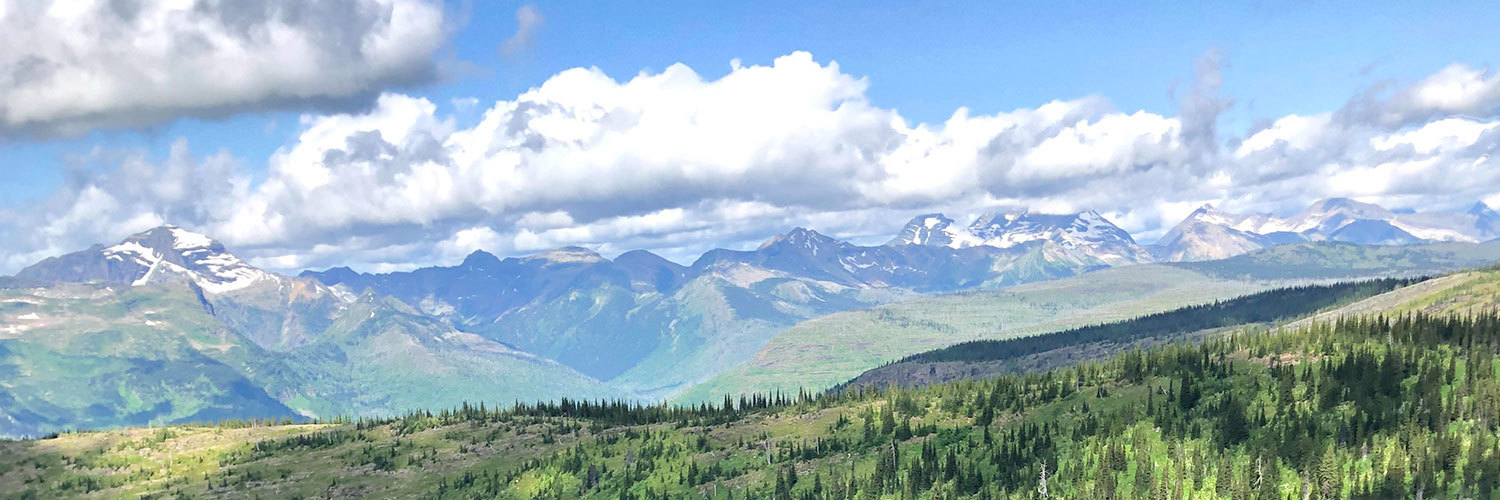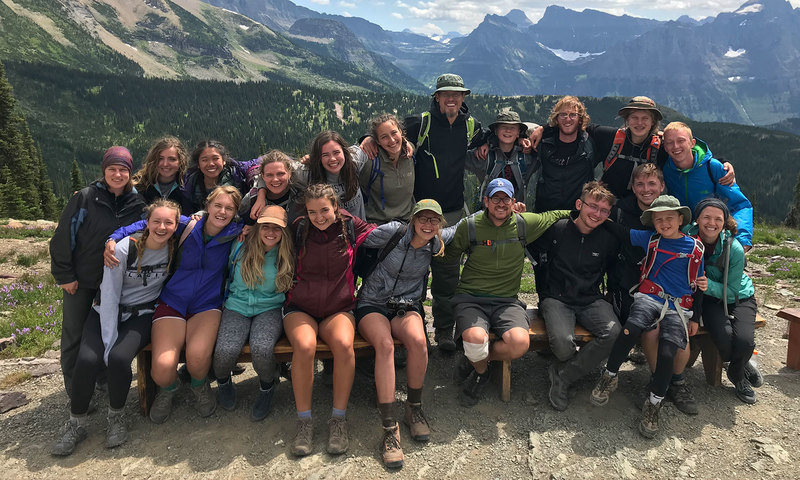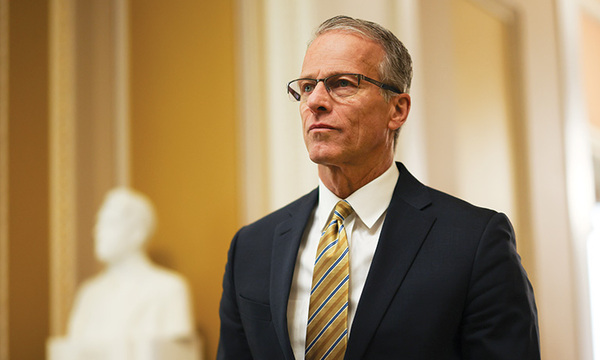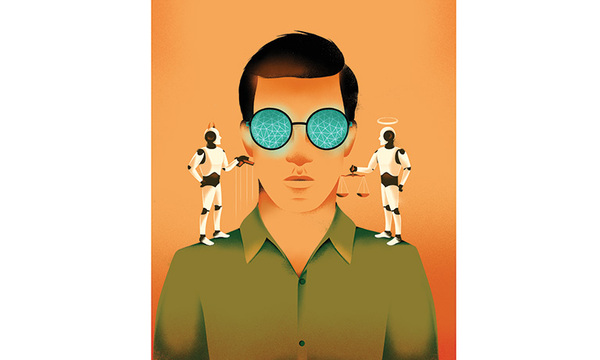Welcome inside the wonder of Torrey National Parks — one of the most adventurous and awe-inspiring courses offered anywhere.
If you ever want to become keenly aware of the limits of language, stand in the shadow of the Grand Tetons. Listen to roaring water tumble over Upper Yellowstone Falls. Hike into the clouds in Glacier National Park. Though Biola’s Torrey Honors Institute is centered on reading and discussion, the richest learning of this summer’s Torrey National Parks trip happened in those moments surpassing words — when worship became a whole-soul expression of awe bordering on fear and joy brimming over.
In The Beginning: Trip Creation And An Invitation
Torrey National Parks was a natural product of the Torrey Honors philosophy. What better way to cultivate love for the Good, True and Beautiful than by blending important texts, complex questions and stunning scenery? Years of ideation and hundreds of hours of preparation made Torrey National Parks a reality. For two weeks during the summer, a small group of students from all years and cohorts would be able to stretch mind, body and soul by taking the Torrey Honors model of learning outdoors — for academic credit.
My addition to Torrey National Parks was much less likely. After being unable to join the inaugural trip as a Torrey student in 2018, I worked through my disappointment and graduated from Biola. Even when tentatively asked about my availability to chaperone its second rendition, I was careful not to get my hopes up. Then, I attended a weekend seminar on C.S. Lewis.
I had just learned Lewis’ distinction between gratitude and worship. Worship, says Lewis, turns thankfulness for a gift into adoration of the Giver. It asks, “What kind of a God must he be, that he would offer this to me?” The class was on break only moments later when I received a text. The question posed by Lewis now brought tears to my eyes as I read the trip leader’s words: “Details to be worked out, but you have received approval from the Vice Provost. This invitation is official. Want to come on Torrey National Parks?”
My lesson in worship was only just beginning.

Crowned In Glory: Grand Teton National Park
Though we had already completed 19 hours of driving, entering Grand Teton National Park in Wyoming felt like the true commencement of our journey. Behind us lay urban centers, small towns, long stretches of empty highway and a Utah sunset whose brilliant coloring seemed a hopeful promise of what was to come. And yet, even this was ill preparation for our first encounter with the Tetons.
Author John McPhee captures it well: the Tetons are “without preamble.” They rise abruptly, with towering, jagged peaks that stretch up to scrape the sky and seem to thunder majesty — a metaphor that becomes literal when they are wreathed in storm clouds. Even in summer, patches of snow grace the places where meadows and forests give way to gray stone. Strings of lakes, tucked just out of sight, are startlingly refreshing to those willing to brave a plunge. It is an untamed place. It is a place to be humbled.
Buckets of rain and occasional hail welcomed us but thankfully left our campground on the opposite end of the park untouched. Seven tents were set up, and soon 21 pillows, sleeping bags, duffels, packs and folding chairs made our little campsite home.
As the trip progressed, we developed new rhythms. Cool mornings were greeted with warm drinks and breakfast. Sandwiches — PBJ or meat and cheese — were packed away for lunch on the trail. “Buddy checks” and sunscreen application became routine; showers became … less routine. Morning psalms were read and cars were loaded. Meals carefully planned by trip leaders were prepared by student dinner crews and demolished by all. Twilight became starlight during book discussions around campfires. Teeth were brushed and tent laughter hushed.
We lost track of the days as the demands of work and home were replaced by concern with simpler, more immediate necessities. Soon, too, our unfamiliarity with each other was replaced by inside jokes that required only a few words to dissolve the group to laughter. It was a recipe for forming a ragtag family.
While evenings were spent delving into the works of authors, days were enjoyed basking in the work of our Creator. Our very first hike taught us that snowmelt rivers make for cold lakes; we would look back on these as some of the warmest of our trip. Cascade Canyon brought with it spontaneous snowball fights, abundant waterfalls and reminders of the value of resilience. White-water rafting filled the afternoon with squeals somewhere between happiness and nervousness. Paintbrush Canyon presented steep ascents, meadows dotted with dozens of varieties of wildflowers and a moose sighting that gave the day an unexpected turn. But against the backdrop of this beauty, a single moment stands out in my mind.
We were driving across the park after white-water rafting when the setting sun began brushing the mountaintops. The cloudburst of moments earlier was disappearing as quickly as it had come, and now the lingering clouds were outlined in bright light that gave new meaning to the words “silver lining.” The view grew more stunning by the moment, leaving us but one choice: we pulled over. As we piled out of cars and into a little turnout that we had all to ourselves, an odd combination of giddiness and a near-solemn rapture settled on our group. We stood with arms thrown across each other’s shoulders, watching. Beholding. The sun crowned the Tetons in brilliance. Then, it began sliding slowly down.
The moment slipped away, but left in its wake a dizzying joy that made you want to laugh — or sing. Sighting a double rainbow and our first grizzlies of the trip on the drive home were the finishing touches on a day that was a masterful gift, beginning to end. Soon, blessedly showered and well-rested, it was time to continue our trek farther north.

Rare Encounters: Yellowstone National Park
Yellowstone is well-known for its thermal features, and for good reason. Sulfurous-smelling water shapes the landscape in ways that sometimes make you think you might be on another planet. Geysers shoot water skyward. Mud pots bubble. Hot springs boast alluring hues that belie perilously high temperatures. Such thermal features are reminders that Yellowstone is very much alive — a volcano so large it is called a “supervolcano.”
Our time in Yellowstone would prove to be the most leisurely part of the trip. But these unhurried days were far from uninteresting. Old Faithful erupted mostly on time. The Grand Prismatic made us marvel while the wind tried to steal our hats. Rapids at Firehole River became natural waterslides. Upper Yellowstone Falls sent thousands of gallons of frothing water hurtling down more than 300 feet to join the river carving the distinctive yellow stone below — earning the area the apt name “Grand Canyon of Yellowstone.” But the best was yet to come.
Wildlife roam freely in Lamar Valley. Bison herds dot the plains. Swallows wheel and play above the streams. Bald eagles stand sentinel on the skeletons of trees. Satisfied from a tasty dinner at Roosevelt Lodge and the beautiful views before us, we drove slowly with windows down and hearts full. The impressively large bison munched grass nearby and even brought our little caravan to a halt for several minutes when they decided to cross the road. But it was the darting pronghorn that signaled the presence of the animal we were really hoping to see.
Wolves had been absent from Yellowstone for more than 70 years before their reintroduction in 1995. As their population grew, restoration cascaded down through the ecosystem. Today, places once overgrazed and prone to erosion are bursting with life — but the creatures responsible for this regeneration are elusive. Regular visitors can go years without a single sighting. The odds were low but our hopes were high.
The first clues were the white rumps of the pronghorn. As they crossed just in front of a herd of bison, their bobbing tails caught our attention, and a sharp-eyed member of our crew then spotted the dark form responsible for their flight. Within moments, we had pulled over the entire caravan, tumbled out of cars, and eagerly began whispering, pointing and asking for binoculars. We watched her trot along, completely unaware of the joy her mere presence was creating. The bison watched too, unconcerned. She passed the first herd and dipped down into a riverbed, emerging on the other side and continuing to cross toward a second herd. Under a tree, a lone bison lay far from its companions. The wolf turned.
The knowledge that wolves hunt in packs made us incredulous as the scene unfolded. She was, indeed, headed straight for the bison. She seemed neither especially stealthy nor quick as she neared; her attempt almost appeared half-hearted. The response incited by her approach was not.
A dozen bison, still many yards away, broke into a run. Several of their heads hung low as they charged, horns pointing outward. The moment was something straight out of a nature documentary. The lone bison was on its feet now, and soon, it would no longer be alone. The herd closed the distance. The wolf, wisely evaluating her odds, simply changed direction, as if suddenly uninterested in the entire situation. We watched her shrink and disappear into the gathering evening.
Long moments later, we still stood smiling. The gratitude was almost tangible, and it would only grow as we witnessed yet another breathtaking sunset that demanded we stop and later watched a mother moose and her two offspring cross just ahead of us as dusk deepened to night. The next day, we left for Montana with spirits high.
The Sound Of Wind: Glacier National Park
Evidence left behind by glaciers is everywhere in Glacier National Park. Valleys are broader and less angular. Rocky beds mark trails of the slow-moving sheets of ice that once sculpted the landscape. Lakes are colored an iridescent blue by glacial silt. It is little wonder why a section of road in the park dubbed the “Highway to the Sun” is considered the most scenic road in the United States.
After the laid-back days of Yellowstone, Glacier prompted us to resume the rhythms of strenuous exploration. The first day, a short 4.6-mile jaunt through cool, shady forest brought us to Avalanche Lake. Day two, we took it up a notch, completing a 10.5-mile hike to Ptarmigan Tunnel and spotting a bull moose and bear along the way. Day three was a day to recoup. We took a boat across Lower Two Medicine Lake for some hiking and swimming before finishing the night and our studies with a final discussion about applying our learning — while lightning illuminated the mountains on all sides. Then, it was time for the finale.
The hike to Grinnell Glacier Overlook is 15.5 miles, which meant an early start. We watched the sun rise over the park while eating breakfast near the trailhead and set off soon after. The first portion of the trail is carved into the mountainside, with a wall on the right and a valley on the left. Gradually, the landscape grew less sheer. We trekked past rock fields, wind-carved ledges and furry marmots before tackling switchbacks and ascending into the clouds.
It is disorienting and thrilling to walk into walls of gray and white so thick you can only see a few feet ahead. Our surroundings were often all but entirely obscured, until — without warning — the wind drew back the shroud and unveiled the valley below. Audible exclamations greeted each sudden appearance. When the clouds finally dissipated entirely, the beauty was so lavish it seemed nearly unreal. Lush forests. High waterfalls. Glistening lakes. Rock that came in shades of red, blue and gray. Mile after mile fell away until we arrived at a fork in the trail. Our final trial had arrived.
Those who dared brave the bonus leg of the hike before us would face the steepest terrain we had yet traversed, but we were determined to reach the top. The hillside was covered in loose rock and the elevation so high that we shared the trail with a mountain goat. The gusts that had blustered all day grew in strength, becoming a force to be reckoned with. We bent under our packs. But still, we climbed.
If the wind and workout had not already stolen our breath, the scene at the top would have. Directly beneath us, a glacier hugged the base of a mountain, the source of the neighboring icy blue lake. Three more lakes lie in succession in nearby valleys, all of them the gem-like turquoise blue that makes glacial lakes so distinctive. On all sides, mountains soared — and with them, our spirits. As the last of our group reached the top, wind-swept and beaming, our voices joined in the Doxology. I would like to think the song echoed downward into the valleys below. But I am confident it carried upward into the heavens above.
Ending An Odyssey: The Road Home
We would return to camp utterly exhausted and deeply content. In the days following, we would drive more than 500 miles and eventually go our separate ways. The trip would live on only in memory, photos and the warmth of new friendships. Yet, like all good Torrey Honors endeavors, it has left me pondering a lifelong question: What kind of a God must he be that even these dim shadows shine so brightly?
Hasten the day when we finally see him face to face. When, though aching and trail-weary, we behold majesty that makes our souls somersault. When in the light of his glory, we learn, at last, to worship.
 Biola University
Biola University




